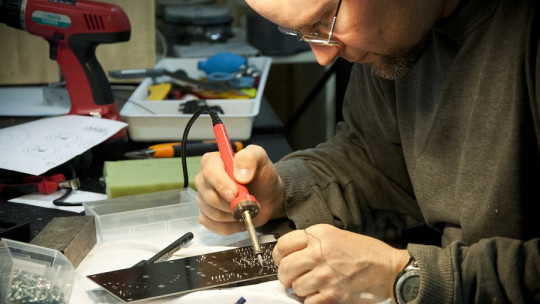It is well known the number of existing professions, and with it, the possibilities of developing at a professional level in one field or another. There are many tools that allow you to identify which occupations or professions best fit certain profiles. One of them is Strong’s Vocational Interest Inventory
This Inventory was developed in 1927 by psychologist Edward Kellog Strong, although it has been revised and modified subsequently. Its objective is to guide people in choosing their professional careers. In this article we will learn about its characteristics, structure, applications, scores and uses. In addition, we will learn about the theory on which this test is based.
Strong’s Vocational Interest Inventory: characteristics
The Strong Vocational Interest Inventory (SVIB) is a psychological test developed by psychologist Edward Kellog Strong Jr. in 1927.
In the first moment, It was developed to guide military personnel leaving the army so that they could find a job suitable to their interests , motivations and personal characteristics. The Inventory has differential forms depending on sex (man or woman), and is made up of 291 items, where the examinee must indicate their preference among three possible answers. Regarding the time of its administration, it takes approximately 25-35 minutes to carry it out.
Strong’s Vocational Interest Inventory was later revised by two other authors, David Campbell and Jo-Ida Hansen. Finally, years later It was published as the Strong-Campbell Interest Inventory
Applications
The Strong Vocational Interest Inventory is used especially in the educational field and in educational and career guidance, with the aim of guiding students in the career or studies that best fit their characteristics and interests.
On the other hand, the Inventory is also used in the area of research, with the objective of analyzing the individual differences of people in relation to their vocational interests. In addition, it is also useful for studying the character and personality of people, as well as the origin and effects of certain types of interests. All of this It can be useful for personnel selection purposes, consulting and business advice
How is it administered?
The examined subject must respond to 291 items with 3 response possibilities, indicating the one that best suits their preferences. The test lasts between 25 and 35 minutes, and what it aims to do is compare the interests of the subject with the interests of people who are engaged in specific occupations or professions
What is it for?
Thus, the Strong Vocational Interest Inventory is a psychological evaluation tool that evaluates a person’s interests at a vocational level. That is, it detects the work activities that could best suit a particular person. It is one of the most used tests to detect vocational interests, especially in North America.
It is based on the preferences of the person examined in various fields, with the aim of find the profession or professions that best fit your psychological and motivational profile Their scores indicate whether the person’s vocational preferences are closer to a certain professional group or another.
Evaluation areas
The Strong Vocational Interest Inventory is made up of 6 areas, where the different items are grouped. These 6 areas are the following: occupations (it is the largest area, made up of 107 items), thematic areas (made up of 46 items), activities (85 items), leisure activities (28 items), people (16 items) and own characteristics (9 items).
Results
Results from the Strong Vocational Interest Inventory include 5 types of scores :
1. Interest level scores
Here the subject is scored in relation to the so-called “General Occupational Themes” (GOT). These form differentiated categories of interest, and characterize the subject examined in 6 different types: investigative, artistic, social, realistic, conventional and entrepreneurial
2. Scores on basic interest scales
In this case, the scores refer to 30 basic scales of interest, related to topics or professions such as art, public speaking or science.
3. Scores on occupational scales
These scores come from 244 scales that refer to different occupations or professions. The Strong Vocational Interest Inventory relates the interests of the person examined with the interests of the people who carry out their work in 122 different occupations or professions
4. Scores on personal style scales
These scores are obtained from 5 scales that refer to personal style. Said style refers to work, leadership, team orientation, learning and risk taking
5. Scores on administrative scales
Finally we found scores obtained from 3 administrative scales; Its objective is to detect possible test errors, as well as unusual profiles.
Vocational interests
But what, in reality, are vocational interests, the object that Strong’s inventory evaluates? On the one hand, interests are those things that motivate us, we like or make us curious. Vocational interests, even more specific, define those areas of study (or work areas) that attract us. That is to say, they are part of what we want to dedicate ourselves to, and they have a lot to do with the vocation.
Vocation, for its part, is an internal sensation that generates an inclination for one subject or another and that guides us when it comes to saying what we want to do in life.
Types of interest
EK Strong took these concepts into account when developing his Inventory. Furthermore, in order to develop Strong’s Vocational Interest Inventory, the author himself relied on the distinction that Fyrer (1931) makes of the types of interests, which can be subjective or objective.
Thus, while subjective interests consist of feelings (positive or negative) in relation to objects or activities, objective interests are all those reactions, also positive or negative, that a person manifests in relation to different objects or behaviors
Aptitudes and interests
But interests also have a lot to do with attitudes. Fryer was the first author to talk about a possible relationship between a person’s aptitudes (abilities to perform certain tasks) and his or her personal interests. Later, Strong himself followed this same theoretical line, conceptualizing his ideas within learning theories.
Thus, in line with the above, and among the ideas that Strong developed to develop the Strong Vocational Interest Inventory, there is also the hypothesis that each person’s abilities cause us to have interests in one thing or others, that is, They are related concepts, and one thing (ability) leads to another (interest)
On the other hand, according to Strong, a person’s interests are actually learned motivations; That is, they would be learned behaviors, based on what we like and what we don’t.









